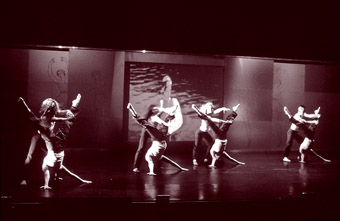Swan Lake with edge
Anne Thompson: ADT, Birdbrain

ADT, Birdbrain
courtesy ADT
ADT, Birdbrain
This is the fourth version of Garry Stewart’s Birdbrain and the second version I’ve seen. It begins with a portable, plastic record player sitting on the empty stage. Kristina Chan sits and plays snatches of the overture to Swan Lake. The record crackles. Stewart’s endeavour is established. This ballet classic will be sifted through contemporary technology and responded to by contemporary bodies.
Tchaikovsky’s music triggers memories of that celebrated ballet of love and deception but there is no time for nostalgia. The overture is intersected by a different music, designed by Jad McAdam and Luke Smiles. This music pumps. The company enters. The dancing in this section is tight, presentational and formal but there’s something electric about these dancers. They are wired for fast, exacting shifts of position, line and spatial orientation. I recognise moves from ballet, Cunningham technique, yoga, acrobatics and breakdancing. But each move is transformed through juxtaposition and the way in which these dancers’ bodies are organised for risk and range. (Stewart loves extreme stretch and moves that require phenomenal strength.) Fiona Malone and Tanja Liedtke appear at one stage in school uniforms. This image is disquieting—ballet as a schoolgirl fantasy, ballerinas as male sexual fantasies. Finally, terms associated with ballet flash at the back of the stage, the video screen framed by panels designed by Gaelle Mellis, each bearing a Renaissance image of a ballet dancer which is barely visible, silver on grey. Ballet history is present but fading. This opening treatise on ballet ends.
Then the real ballet begins. Ideas, images, references to Swan Lake flash past us in the movement, as words printed on T-shirts, as images behind the video screen and in Tim Gruchy’s video footage. The use of language to denote aspects of the original ballet makes the commentary hard-edged. For instance, at one stage a dancer labelled “royal disdain” duets briefly with a dancer labelled “peasant joy.” However, this hard-edged wit plays second fiddle to the dancing. A few of the highlights are: Larissa McGowan’s solo in which she turns herself inside out, shuddering and quivering as she transforms from a swan into a woman; Antony Hamilton’s ‘the story so far’ and ‘dying swan’ dance behind a pulsing, slow zoom in on a photo of one of the famous Odette/Odiles taking a bow (strangely moving); the linked-arm quintet of Queen, evil Rothbart, Prince Siegfried, Odette and Odile, making these characters an entwined entity; the ‘drowning of the lovers’ in which the dancers run in, perform spread-eagled leaps, face to the floor and then roll.
This company is hot. This piece might have started as a tongue-in-cheek critique, as suggested by the title, but the dancing no longer relies on quotation for effect. The virtuosic physical material has a thrilling kinaesthetic and expressive logic that I found riveting.
–
Birdbrain, ADT, conceived/directed by/choreography Garry Stewart, dancers from Thwack and ADT: Anton, Craig Bary, Kristina Chan, Roland Cox, Antony Hamilton, Tanja Liedtke, Lina Limosani, Larissa McGowan, Fiona Malone, Matthew Morris, Craig Procter, The Playhouse, Adelaide, June 29
RealTime issue #44 Aug-Sept 2001 pg. 37






